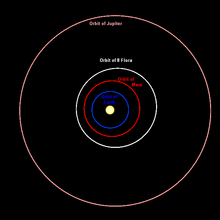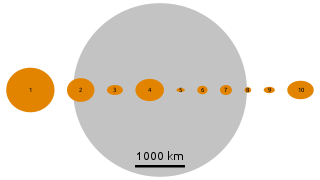8 Flora
Flora (minor planet designation: 8 Flora) is a large, bright main-belt asteroid. It is the innermost large asteroid: no asteroid closer to the Sun has a diameter above 25 kilometres or two-elevenths that of Flora itself, and not until the tiny 149 Medusa was discovered was a single asteroid orbiting at a closer mean distance known.[7] It is the seventh-brightest asteroid with a mean opposition magnitude of +8.7.[8] Flora can reach a magnitude of +7.9 at a favorable opposition near perihelion, such as occurred in November 2007. Flora may be the residual core of an intensely heated, thermally evolved, and magmatically differentiated planetesimal which was subsequently disrupted.[9]
.png) A lightcurve-based 3D-model of Flora | |
| Discovery | |
|---|---|
| Discovered by | J.R. Hind |
| Discovery date | 18 October 1847 |
| Designations | |
| (8) Flora | |
| Pronunciation | /ˈflɔːrə/ |
Named after | Flōra |
| Main belt (Flora family) | |
| Adjectives | Florian /ˈflɔːriən/ |
| Orbital characteristics[1] | |
| Epoch November 26, 2005 (JD 2453700.5) | |
| Aphelion | 380.850 Gm (2.546 AU) |
| Perihelion | 277.995 Gm (1.858 AU) |
| 329.422 Gm (2.202 AU) | |
| Eccentricity | 0.1561 |
| 1193.549 d (3.27 a) | |
| 156.401° | |
| Inclination | 5.886° |
| 111.011° | |
| 285.128° | |
| Proper orbital elements[2] | |
Proper semi-major axis | 2.2014283 AU |
Proper eccentricity | 0.1448717 |
Proper inclination | 5.5736218° |
Proper mean motion | 110.205216 deg / yr |
Proper orbital period | 3.26663 yr (1193.138 d) |
Precession of perihelion | 32.016655 arcsec / yr |
Precession of the ascending node | −35.510731 arcsec / yr |
| Physical characteristics | |
| Dimensions | 136 km × 136 km × 113 km[3] 145 km × 145 km × 120 km[4] |
Mean diameter | 128 km[3] |
| Mass | (6.62±0.84)×1018 kg[lower-alpha 1][5] |
Mean density | 3.04±1.39 g/cm3[5] |
| 0.533 d (12.799 h)[1] | |
| 0.243[1] | |
| S[1] | |
| 7.9[6] to 11.6 | |
| 6.49[1] | |
| 0.21" to 0.053" | |
Discovery and naming
Flora was discovered by J. R. Hind on October 18, 1847. It was his second asteroid discovery after 7 Iris.
The name Flora was proposed by John Herschel, from Flora, the Latin goddess of flowers and gardens, wife of Zephyrus (the personification of the West wind), and mother of Spring. The Greek equivalent is Chloris, who has her own asteroid, 410 Chloris, but in Greek Flora is also called Chloris (8 Χλωρίς).
Characteristics

Lightcurve analysis indicates that Flora's pole points towards ecliptic coordinates (β, λ) = (16°, 160°) with a 10° uncertainty.[4] This gives an axial tilt of 78°, plus or minus ten degrees.
Flora is the parent body of the Flora family of asteroids, and by far the largest member, comprising about 80% of the total mass of this family. Nevertheless, Flora was almost certainly disrupted by the impact(s) that formed the family, and is probably a gravitational aggregate of most of the pieces.
Flora's spectrum indicates that its surface composition is a mixture of silicate rock (including pyroxene and olivine) and nickel-iron metal. Flora, and the whole Flora family generally, are good candidates for being the parent bodies of the L chondrite meteorites.[10] This meteorite type comprises about 38% of all meteorites impacting the Earth.
Observational mishap
During an observation on March 25, 1917, 8 Flora was mistaken for the 15th-magnitude star TU Leonis, which led to that star's classification as a U Geminorum cataclysmic variable star.[11] Flora had come to opposition on 1917 February 13, 40 days earlier.[11] This mistake was uncovered only in 1995.[11][12]
Occultation
On July 26, 2013, Flora at magnitude 8.8 occulted the star 2UCAC 22807162 over parts of South America, Africa, and Asia.[13]
Popular culture
In the 1968 science-fiction film The Green Slime, an orbital perturbation propels the asteroid Flora into a collision course with Earth.

Notes
- 3.33 ± 0.42) × 10−12 M☉
References
- "JPL Small-Body Database Browser: 8 Flora". Retrieved 27 November 2008.
2008-04-14 last obs
- "AstDyS-2 Flora Synthetic Proper Orbital Elements". Department of Mathematics, University of Pisa, Italy. Retrieved 1 October 2011.
- Jim Baer (2008). "Recent Asteroid Mass Determinations". Personal Website. Archived from the original on 2 July 2013. Retrieved 27 November 2008.
- Torppa, Johanna; Kaasalainen, Mikko; Michalowski, Tadeusz; Kwiatkowski, Tomasz; Kryszczynska, Agnieszka; Denchev, Peter; et al. (August 2003). "Shapes and rotational properties of thirty asteroids from photometric data". Icarus. 164 (2): 346–383. Bibcode:2003Icar..164..346T. CiteSeerX 10.1.1.694.1087. doi:10.1016/S0019-1035(03)00146-5.
- James Baer, Steven Chesley & Robert Matson (2011) "Astrometric masses of 26 asteroids and observations on asteroid porosity." The Astronomical Journal, Volume 141, Number 5
- Donald H. Menzel & Jay M. Pasachoff (1983). A Field Guide to the Stars and Planets (2nd ed.). Boston, MA: Houghton Mifflin. pp. 391. ISBN 0-395-34835-8.
- Binsel, Richard P.; Gehrels, Tom and Matthews, Mildred Shapley (editors); Asteroids II; published 1989 by University of Arizona Press; pp. 1038-1040. ISBN 0-8165-1123-3
- The Brightest Asteroids (archived)
- Gaffey, Michael (1984). "Rotational spectral variations of asteroid (8) Flora: Implications for the nature of the S-type asteroids and for the parent bodies of the ordinary chondrites". Icarus. 60 (1): 83–114. Bibcode:1984Icar...60...83G. doi:10.1016/0019-1035(84)90140-4.
- Nesvorný, D.; et al. (2002). "The Flora Family: A Case of the Dynamically Dispersed Collisional Swarm?". Icarus. 157 (1): 155–172. Bibcode:2002Icar..157..155N. doi:10.1006/icar.2002.6830.
- Schmadel, L. D.; Schmeer, P.; Börngen, F. (August 1996). "TU Leonis = (8) Flora: the non-existence of a U Geminorum star". Astron. Astrophys. 312: 496. Bibcode:1996A&A...312..496S.
- "IAUC 6174".
- Asteroid Occultation Index Page
External links
- shape model deduced from lightcurve
- "Announcement of discovery of Flora", MNRAS 8 (1848) 82
- 8 Flora at AstDyS-2, Asteroids—Dynamic Site
- 8 Flora at the JPL Small-Body Database
